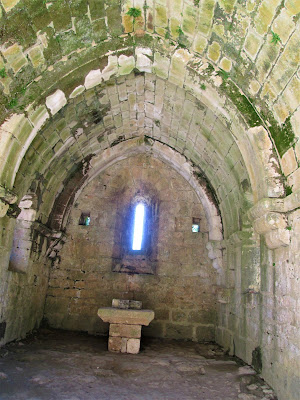One of our favourite authors is Martin Walker who
lives for part of each year here in the Perigord region. Amongst many other
things, Martin writes a series of policiers
with the central character a local policeman called Bruno. We love the way
that Martin incorporates the food, wine and culture of this region into each of
his books. Each is based on a feature of the local history, whether it’s
prehistoric cave art, the resistance during WW11 or the wine industry. His latest book is called The Templar’s Last
Secret and talks about the Chateau de Commarque , so we decided we should visit
this site since it’s not so far away.
On a very hot Sunday, we drove deep into the countryside in search of the ruins of this chateau. The area is forested and the roads just one lane wide and in poor condition. Luckily there are signposts or we would never have found it.
A group of car enthusiasts had the same idea, judging by what was in the carpark huddled in the shade of the trees.
We had taken Lily with us for a bit of exercise and culture and she does love exploring new places.
 |
| Lily not looking entirely happy with the idea of a walk on a hot day |
 |
| the path disappearing into the forest and no sign of the chateau yet |
It was a 600 metre walk downhill through the
forest to the base of the chateau. Apparently, when the chateau was inhabited,
the valley floor was 20 metres lower
than it is today, so the surrounding countryside would have looked very
different.
 |
| the forests here are delightfully cool and lush |
 |
| you'd never know it was almost 40 degrees in the sunshine |
 |
| and here we are ! |
Now there is simply a small stream wandering through meadows with a few cows. The base of the cliff opposite is a complex of abandoned troglodyte caves which would have been high above the valley when this was a thriving community.
 |
you can see what would have been cave openings
when the valley floor was much lower |
There is evidence that man has lived in the
Perigord region for 100,000 years so it has always been considered a desirable
address. Beneath the chateau is an example of cave art said to be 15,000 years
old. Who knows how long people have lived in the caves, but this fortress was
built during the twelfth century .
 |
| a view of the neighbour |
 |
| the original gateway into the fortress |
 |
| the great hall as it would have been... |
 |
| ...and as it is now |
 |
| an original door... |
 |
| ...and it's replacement |
 |
in the Dordogne this is called a chabanos.
It could have been used as a shepherd's hut,
a toolshed, a henhouse, anything |
 |
| another view of the neighbouring chateau from the guardhouse |
The neighbouring chateau
is privately owned and not open to the public and I wasn't able to find any
information on it's history. The Dordogne region is known as " the land of
1000 chateaux" and I'm sure there is even more than that . It is always a
surprise in winter when the trees have dropped their leaves to be driving along
and discover a chateau that was hidden from view during the summer. This area
is known as Perigord Noir (black) because of the lush, dark holm oak forests,
as you can see.
There
are so many fascinating places to visit in this country and we haven't
scratched the surface yet.
After la
canicule ( heatwave) of the past couple of weeks, we now have cooler
stormy weather. So, so pleased for the change and the garden is grateful for
the rain.
J'espère vous voir bientôt






























What a fabulous looking place!
ReplyDeleteWe are surrounded by such places, Susan. It's taking us years to see them all.
DeleteOur visit to Commarque was in a stormy afternoon with dark clouds behind the ruins. It was very atmospheric and a highlight of out walking tour. A fascinating place!
ReplyDeleteOutstanding post. Also loved the pics of classic cars.
ReplyDelete